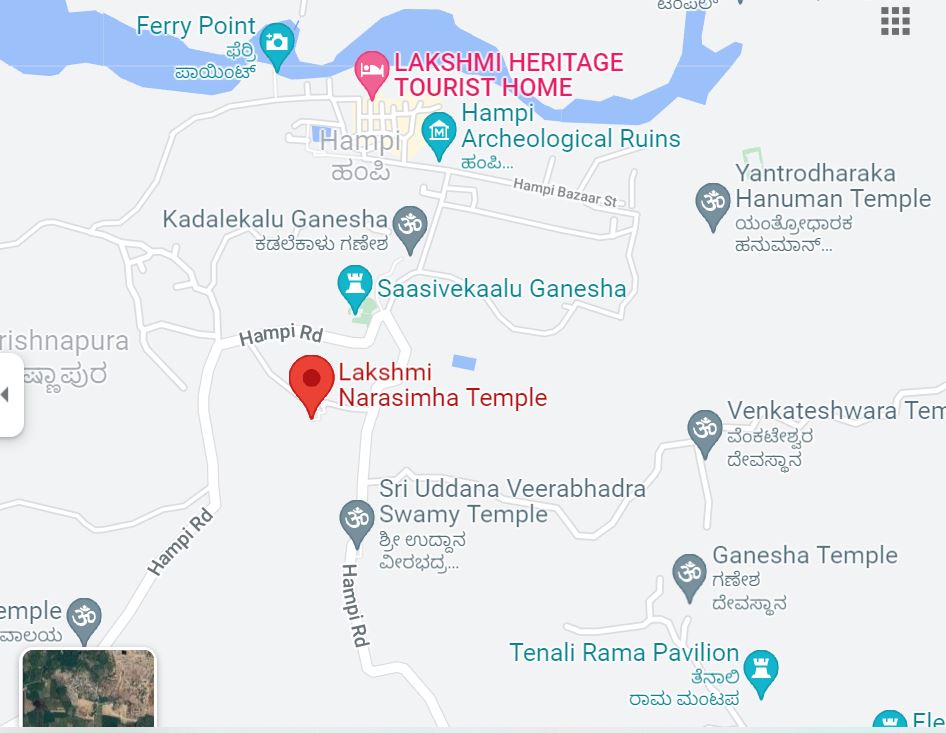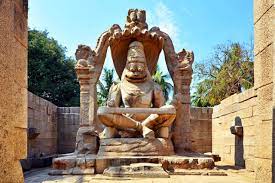30 October 2021, Plava varusha, Aippasi-13, Saturday;
The Lakshmi Narasimha statue is one of the most imposing sculptures found in the ruined town of Hampi. The speciality of the sculpture is that it is the largest monolith statue in Hampi. The statue is located on the southern side of the Hemakuta group of temples that stand on the Hemakuta Hill.

This gigantic stone structure is considered to be among the most important monuments found in Hampi. It is a major tourist attraction and is visited by a large number of people throughout the year.
FACTS ABOUT THE PLACE:
- Timings: 6:00 AM to 6:00 PM on all days of the week
- Entry Fee: No entry fee required
- Photography: Allowed
- Visit Duration: About 1 ½ hours
- Best time to visit: From October to February
HISTORY:
The Lakshmi Narasimha statue and the temple housing the statue were built in the year 1528 A.D. It was constructed during the rule of King Krishnadevaraya, one of the greatest rulers of the Vijayanagara Empire.
The temple is dedicated to Lord Narasimha, one of the ten avatars of Lord Vishnu, and Goddess Lakshmi. As such, the temple is known as the Lakshmi Narasimha Temple.
The original sculpture had a small figure of Goddess Lakshmi, consort of Narasimha, sitting on his lap. The gigantic statue was vandalized and mutilated in 1565 A.D. during the raid by the Mughals that led to the fall of the Vijayanagara Empire. The Lakshmi Narasimha statue at this place, is a brilliant work of architecture. It is a rare statue with a huge size and was crafted with great details. The statue is 6.7 metres height. It is one of the finest example of the Vijayanagara style of architecture.The statue of Narasimha has a finely chiselled broad chest and a well-defined mane. Narasimha is adorned with a beautiful Kireedom and is seen seated in a (cross-legged)Yogasana position. The sculpture portrays Narasimha sitting on the Adishesha, the king of all snakes, which rises behind him with its seven hoods.
The hoods have been beautifully designed to serve as a canopy over Narasimha’s head. The sculpture is set within a Makara thorana. There is a lion-mask set above the hoods of Adishesha. This is a master piece of the Vijayanagar style of Architecture.
The most unique feature of the statue is the bulging eyes of Narasimha. The large round protruding eyes provides the statue with an exceptional and majestic look. Though the statue of Lakshmi is no longer sitting on the lap of Narasimha, one can imagine the beauty of the complete statue in its original form, before the damage.

It is really amazing to note that such a huge sculpture was crafted from a single boulder of granite. The sculpture displays the expertise of the craftsmen of that ancient era.

According to Hindu mythology,
Narasimha is the fourth incarnation of Vishnu and appeared on earth in the form of half human (Nara) and half lion (Simha). Narasimha is believed to have the face and claws of a lion, and torso and lower body of a human. As such, the huge statue in the Lakshmi Narasimha temple of Hampi has the face of a lion and the body of a human. The mane and the wide jaw of Narasimha clearly express the features of a lion.

There are two theories about the form of Narasimha portrayed through the statue. One theory suggests that the statue represents the Ugra Narasimha (fierce Narasimha) form. The reason stated is that the statue has a fierce appearance, expressed through the protruding eyes and the scary facial expression. The absence of Goddess Lakshmi beside the God also added to the relevance of this theory.
The other theory suggests that the statue represents the Malola Narasimha form. The reason stated is that, in this statue Narasimha is seen with his consort Goddess Lakshmi sitting on his lap (though the figure is now damaged). Malola is a combination of two words – Ma meaning Goddess Lakshmi and Lola meaning beloved.

Regardless of the form of Narasimha the statue represents, it is undoubtedly, a reflection of the rich artistic heritage of the Vijayanagara Empire.
How to Reach:
Hampi is a world famous tourist destination that draws visitors from all over the world. There are several ways to reach Hampi from various towns and cities of Karnataka and other parts of India.
The location of Lakshmi Narasimha statue, based on the southern side of the Hemakuta group of temples, is a well-known spot in Hampi and is easily accessible from all parts of the ruined town.

By Air
Hampi is an ancient village with no airport of its own. Ballari (Bellary) is the closest town that has an airport. Bellary stands at a distance of around 64 km from Hampi. Visitors can take a flight to Bellary and then reach Hampi by means of local transport.

By Rail
Hampi is a place that is devoid of a railway station. The nearest railway station is situated in the city of Hospet. It has the Hospet Junction Railway Station. Hospet is at a distance of around 10 km from Hampi. One of the simple ways to reach Hampi from Hospet is to travel through a bus. Other means of local transport are also available for visitors to reach Hampi from Hospet.
By Road
Hampi has a strong road network and is connected to a number of towns and cities by means of this network. There are a lot of buses that travel between Hampi and several other towns and cities in Karnataka.
Visitors can also hire private cars, cabs or other vehicles from big cities like Bengaluru or Mysuru to travel to Hampi.









